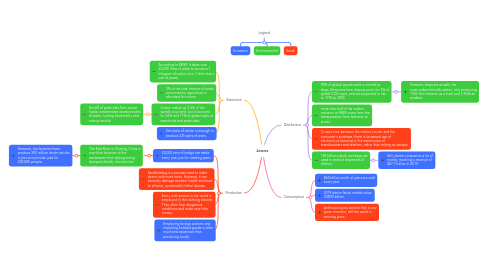Jeans
by Kingsley Chan


1. Extraction
1.1. According to WWF, it takes over 20,000 litres of water to produce 1 kilogram of cotton (one 1-shirt and a pair of jeans).
1.2. 3% of the total amount of water consumed by agriculture is allocated for cotton.
1.3. Cotton makes up 2.4% of the world’s crop land, but it accounts for 24% and 11% of global sales of insecticide and pesticides.
1.3.1. Runoff of pesticides from cotton fields contaminates nearby bodies of water, hurting biodiversity and raising toxicity.
1.4. One bale of cotton is enough to produce 225 pairs of jeans.
2. Production
2.1. 20,000 tons of indigo are made every year just for creating jeans.
2.1.1. The East River in Xintang, China is now blue because of the wastewater from dyeing being dumped directly into the river
2.1.1.1. However, the factories there produce 300 million denim articles a year and provide jobs for 220,000 people.
2.2. Sandblasting is a process used to make denim look more worn. However, it can seriously damage workers’ health and lead to silicosis, a potentially lethal disease.
2.3. Every sixth person in the world is employed in the clothing industry. They often face dangerous conditions and make very little money.
2.4. Employing foreign workers and importing finished goods is often much less expensive than producing locally.
3. Legend
3.1. Economic
3.2. Environmental
3.3. Social
4. Distribution
4.1. 90% of global goods trade is carried by ships. Emissions from ships account for 3% of global CO2 input, and are projected to rise to 17% by 2050.
4.1.1. However, ships are actually the most carbon-friendly option, only producing 1/5th the emission as a truck and 1/50th an airplane.
4.2. more than half of the carbon emission at H&M come from the transportation from factories to stores.
4.3. To save time between the retailer's order and the consumer's purchase, there is increased use of electronic processing in the warehouses of manufacturers and retailers, rather than relying on people.
4.4. 180 billion plastic polybags are used to protect shipments of clothes.
4.4.1. Still, plastic companies a lot of money, reaching a revenue of $27.7 billion in 2019
